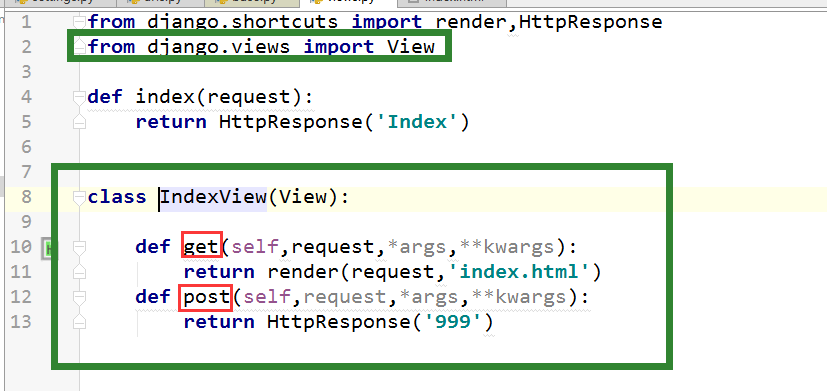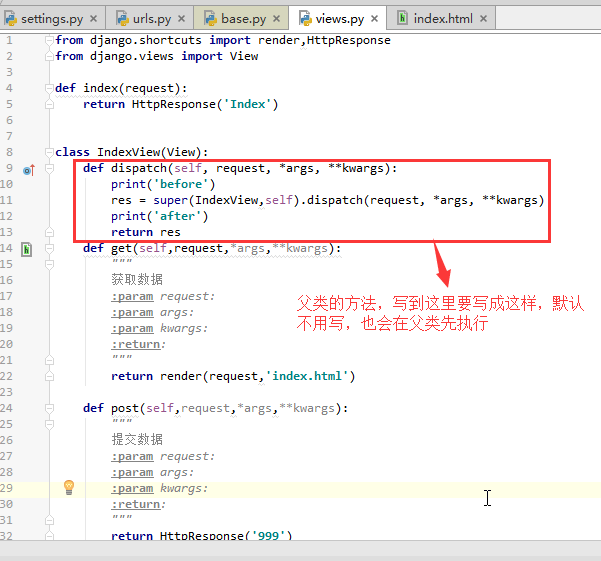django中请求处理方式有2种:FBV 和 CBV
一、FBV
FBV(function base views) 就是在视图里使用函数处理请求。
看代码:
urls.py
|
1
2
3
4
5
6
7
8
|
fromdjango.conf.urlsimporturl, include# from django.contrib import adminfrommytestimportviewsurlpatterns=[ # url(r‘^admin/‘, admin.site.urls), url(r‘^index/‘, views.index),] |
views.py
|
1
2
3
4
5
6
7
8
9
|
fromdjango.shortcutsimportrenderdefindex(req): ifreq.method==‘POST‘: print(‘methodis:‘+req.method) elifreq.method==‘GET‘: print(‘methodis:‘+req.method) returnrender(req, ‘index.html‘) |
注意此处定义的是函数【def index(req):】
index.html
|
1
2
3
4
5
6
7
8
9
10
11
12
13
|
<!DOCTYPE html><html lang="en"><head> <meta charset="UTF-8"> <title>index</title></head><body> <form action="" method="post"> <inputtype="text"name="A"/> <inputtype="submit"name="b"value="提交"/> </form></body></html> |
上面就是FBV的使用。
二、CBV
1、CBV(class base views) 就是在视图里使用类处理请求。


分别处理get和post请求
get和post方法是如何被调用的?????
实际上父类View中有一个dispatch方法,作用就是通过反射来调用子类的get和post方法。
请求先走dispatch,res就是get方法或者post方法执行只有的结果
所以这个请求的过程是:请求--->dispatch--->get/post
我们现在把dispatch写到子类中,继承父类的dispatch方法。dispatch写到子类或者单独写一个类,目的是根据需求加功能。

2、我现在想实现验证登录的功能(用CBV实现登录验证不如用中间件,所以我们一般用中间件来实现验证功能)
下面的函数是实现登录的
def dispatch(self, request, *args, **kwargs):
return super(LoginView,self).dispatch(request, *args, **kwargs)
def get(self,request):
print('login')
return render(request,'login.html')
def post(self,request):
# request.GET
# request.POST # 请求头中的:content-type
# 注意:request.POST中的数据是request.body中转换过来的,可能为空,因为可能转换会不成功
# request.body 但凡以post提交数据,request.body中一定有值
user = request.POST.get('user')
pwd = request.POST.get('pwd')
if user == 'alex' and pwd == "alex3714":
# 生成随机字符串
# 写浏览器cookie: session_id: 随机字符串
# 写到服务端session:
# {
# "随机字符串": {'user_info':'alex}
# }
request.session['user_info'] = "alex" # 这个代码有上面注释的几个操作
return redirect('/index.html')
return render(request, 'login.html')

把dispatch拿出来单独写一个类,这个类提供验证登录的功能,让其他类来继承,如下:
class AuthView(object):
def dispatch(self, request, *args, **kwargs):
if not request.session.get('user_info'):
return redirect('/login.html')
res = super(AuthView,self).dispatch(request, *args, **kwargs)
return res
class IndexView(AuthView,View):
def get(self,request,*args,**kwargs):
return render(request,'index.html')
def post(self,request,*args,**kwargs):
return HttpResponse('999')
class OrderView(AuthView,View):
def get(self,request,*args,**kwargs):
return render(request,'index.html')
def post(self,request,*args,**kwargs):
return HttpResponse('999')
3、对于CBV加装饰器的方法
如果加装饰器,需要导入method_decorator
加装饰的格式@method_decorator(test),test是装饰器函数
def test(func):
def inner(*args,**kwargs):
return func(*args,**kwargs)
return inner
可以加在类上,但是加到类上需要指定使用的方法名
@method_decorator(test,name='get') class LoginView(View):
可以加到dispatch方法,也可以加到get或post方法,不需要传name="方法名"
@method_decorator(test) def dispath(self,request,*args,**kwargs):
4、特殊装饰器:CSRF Token只能加到dispatch(django的bug)
CBV的csrf装饰器需要导入
from django.views.decorators.csrf import csrf_exempt,csrf_protect
csrf_exempt是全局需要,唯独这个不需要
csrf_protect是全局不需要,唯独这个需要
@method_decorator(csrf_exempt) def dispatch(self, request, *args, **kwargs): return super(LoginView,self).dispatch(request, *args, **kwargs)